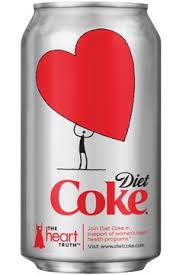February 20th, 2011 by John Mandrola, M.D. in Opinion, Research
No Comments »

 It tastes sweet. It’s pleasurably fizzy. And free of calories. What’s more, the FDA says NutraSweet (aspartame) is safe. So what’s not to like about diet soft drinks?
It tastes sweet. It’s pleasurably fizzy. And free of calories. What’s more, the FDA says NutraSweet (aspartame) is safe. So what’s not to like about diet soft drinks?
A bunch. The ongoing debate about the healthiness of diet soft drinks reminds me of the old adage, “If something sounds to be true, it probably is.”
Artificially-sweetened “diet” drinks get touted as healthy alternatives to sugary drinks because they contain no calories or carbohydrates. On paper it seems plausible to think they are inert, no more dangerous than water. The Coca-Cola Company sublimely strengthens this assertion by putting a big red heart on Diet Coke cans.
But diet-cola news (Los Angeles Times) presented at the International Stroke Conference 2011 suggests otherwise. This widely-publicized observational study of 2,500 older patients (average age=69) from New York showed that drinking diet soda on a daily basis increased the risk of having a heart attack or stroke by 61 percent. The abstract — not a peer-reviewed study — stated that this association persisted after controlling for other pertinent variables.
Sure, this is only a look back at 559 patients who had a vascular event. The study asserts only an association, not that diet colas cause heart attacks and strokes. That’s a big difference.
That said, however, I don’t view these results as trivial either. This trial builds on the results of prior studies of diet drinks which strongly suggest that despite their lack of calories, diet drinks don’t prevent obesity. Read more »
*This blog post was originally published at Dr John M*
February 9th, 2011 by IsisTheScientist in Opinion, Research
No Comments »

 I can already tell that this pregnancy is different from my first. When I was pregnant with Little Isis, I drank no caffeine and took no over-the-counter medication. I remember having a few headaches and Mr. Isis fighting with me to take a headache pill. I would then proclaim dramatically, “But I can’t! What if it hurts the baby?!”
I can already tell that this pregnancy is different from my first. When I was pregnant with Little Isis, I drank no caffeine and took no over-the-counter medication. I remember having a few headaches and Mr. Isis fighting with me to take a headache pill. I would then proclaim dramatically, “But I can’t! What if it hurts the baby?!”
This morning, now pregnant with my second, I washed down a Zyrtec and two Tylenol with a cup of coffee. The little bugger is going to have to grow up with Little Isis. He might as well start building up his tolerance to exogenous substances at some point. I figure, now that its got a closed neural tube and a beating heart, we might as well begin.
Still, you can’t blame a pregnant woman for being a bit neurotic. The feeling that one is solely responsible for the well-being of a developing creature, combined with often contradictory advice, is enough to make anyone nuts. Most online advice is completely and utterly useless. Take this answer from Russell Turk, M.D. on the popular pregnancy website BabyCenter in response to the common question, “Is it safe to drink diet soda during pregnancy?” He answers:
Diet sodas often contain both caffeine and an artificial sweetener. There are several types of artificial sweeteners you may see on nutrition labels:
Aspartame (NutraSweet): Seems to be okay when consumed in moderation (the amount found in one or two 12-ounce servings of soda per day).
Saccharin (Sweet’n Low): Saccharin was found to cause birth defects in laboratory rats when consumed in very high amounts. Because its safety in smaller amounts is hard to prove, I would advise avoiding it.
Sucralose (Splenda): This relatively new sweetener, a modified form of regular table sugar, appears to be safe. But because it hasn’t been extensively studied, it’s best used in moderation.
It’s generally bad advice and leaves one wondering: “What is moderation? Will one soda hurt my baby? Will two sodas hurt my baby? How about three?” The default answer when we don’t know seems to be to tell women to do things in “moderation.” This places the sole responsibility on her to know what moderation means, and allows her to feel the guilt if something goes wrong. I think that these imprecise answers leave many women feeling helpless and afraid. Read more »
*This blog post was originally published at The Brain Confounds Everything*
January 27th, 2011 by BarbaraFicarraRN in Expert Interviews, Health Tips
No Comments »


Information circulating about the dangers of plastic containers has created fear and confusion. Are plastic containers toxic? Do harmful chemicals leach out into its contents? Do we need to discard all plastic containers?
Recently, I interacted in a live health chat on MedHelp about the safety of plastics. Scientist, Joe Schwarcz, Ph.D., Director of McGill University’s Office for Science and Society, talked about “The Real Truth About Plastics: What You Should And Shouldn’t Worry About.”
While Dr. Schwarcz states that some plastics like those made by Tupperware and Rubbermaid are safe to use, there are other plastics made of Bisphenol A (BPA) that may cause some concern, however he did not become alarmed.
There is extensive information on the safety of plastics, and reading some of it can easily cause panic and confusion, but the smartest step health consumers can do for themselves is to remain calm and don’t become alarmed. Gather the facts and determine what’s best for you.
The Facts About Bisphenol A (BPA)
Bisphenol A (BPA) is used to manufacture polycarbonate plastics. This type of plastic is used to make some types of beverage containers, compact disks, plastic dinnerware, impact-resistant safety equipment, automobile parts, and toys. BPA epoxy resins are used in the protective linings of food cans, in dental sealants, and in other products.
General exposure to BPA at low levels comes from eating food or drinking water stored in containers that have BPA. Small children may be exposed by hand-to-mouth and direct oral (mouth) contact with materials containing BPA. Dental treatment with BPA-containing sealants also results in short-term exposure. In addition, workers who manufacture products that contain BPA can be exposed.
How Does BPA Get Into The Body?
BPA can leach into food from the epoxy resin lining of cans and from consumer products such as polycarbonate tableware, food storage containers, water bottles, and baby bottles. Additional traces of BPA can leach out of these products when they are heated at high temperatures. Read more »
*This blog post was originally published at Health in 30*
December 11th, 2010 by Glenn Laffel, M.D., Ph.D. in Better Health Network, News, Research
No Comments »

 Scientists know that our perceptions about taste and texture drive our food preferences. They know quite a lot about the role of taste in this regard, and the results of some recent experiments have shed new light on the role of texture as well, particularly as it relates to foods containing starch.
Scientists know that our perceptions about taste and texture drive our food preferences. They know quite a lot about the role of taste in this regard, and the results of some recent experiments have shed new light on the role of texture as well, particularly as it relates to foods containing starch.
Starch is a major component of potatoes, rice, corn, wheat and the enormous variety of foods derived from them. It is also added to many other products from maple syrup to pudding. In fact, starch accounts for 40 to 60 percent of the calorie content in the average Western diet, and more than that in many Asian and third-world diets.
Humans begin digesting starch in the mouth, where the salivary glands secrete an enzyme known as amylase. This enzyme breaks down starch and other complex carbohydrates into simpler sugar molecules which end up being absorbed from the small intestine into the bloodstream. Read more »
*This blog post was originally published at Pizaazz*
November 25th, 2010 by DrWes in Better Health Network, Health Tips, News, Opinion, Research
No Comments »

 It seems the Washington Post, cloaked under an anonymous author, wants to use scare tactics to keep most of us from enjoying Thanksgiving with their ominously titled article, “And for dessert, a heart attack?” They spew all kinds of garbage with very little data about how eating a high-fat diet might give you a heart attack.
It seems the Washington Post, cloaked under an anonymous author, wants to use scare tactics to keep most of us from enjoying Thanksgiving with their ominously titled article, “And for dessert, a heart attack?” They spew all kinds of garbage with very little data about how eating a high-fat diet might give you a heart attack.
If you want to know more, consider this article* from some pretty smart folks at Harvard. Then eat, drink, and be merry without guilt (courtesy of Dr. Wes). Happy Thanksgiving!
– WesMusings of a cardiologist and cardiac electrophysiologist.
*REFERENCE: Renata, M. and Mozaffarian, D. “Saturated Fat and Cardiometabolic Risk Factors, Coronary Heart Disease, Stroke, and Diabetes: a Fresh Look at the Evidence.” Lipids, 31 Mar 2010.
[Photo credit: Lambert]
*This blog post was originally published at Dr. Wes*
It tastes sweet. It’s pleasurably fizzy. And free of calories. What’s more, the FDA says NutraSweet (aspartame) is safe. So what’s not to like about diet soft drinks?


















